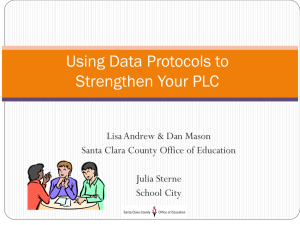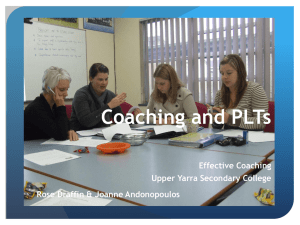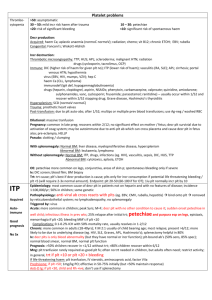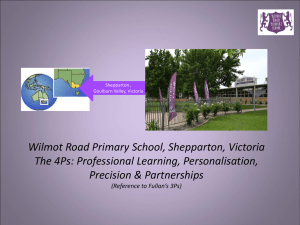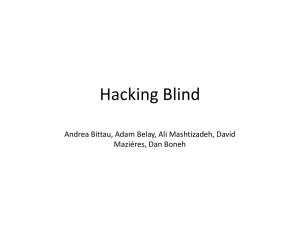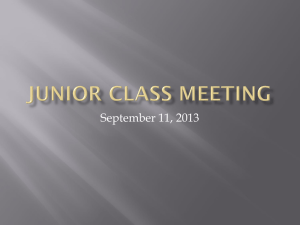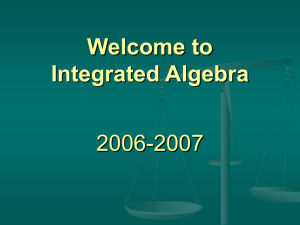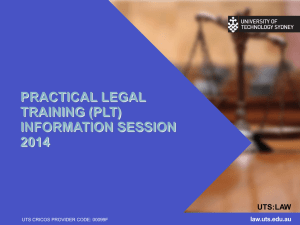vlnskurumburranumlitmarch2011
advertisement
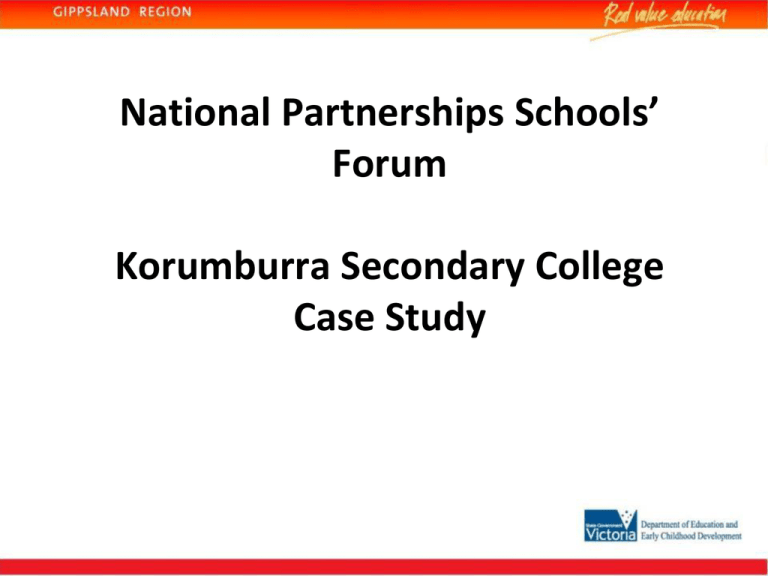
National Partnerships Schools’ Forum Korumburra Secondary College Case Study Algebra, Differentiation and the PLT South Gippsland Maths Initiative 2009 Ideas that resonated • From inference to evidence • Data led collaborative inquiry • PLT – sharing - “Our” students not “my” students • importance of team leadership - Purpose - Process - Structure Coaching 2009 Effect/influence of coaching • focus on the main idea/s for each lesson/unit • Development of differentiated tasks/activities • How will I know what students have learnt? • Reflection with the coach after the lesson • Model these coaching ideas with members of my staff • PLT focus – staff to try at least one of the activities with their classes and provide feedback Last year 2010 • Development of units which include - pre-tests – a move away from text driving teaching and methodology - data collection at relevant times - focus on the big ideas and links to the developmental continuum - one task which allows for differentiation - starting to listen for the “golden question” and its implications for my practice. • link Year 7 units to Year 8 program • TPL • Patrick Griffin – Specialist Certificate in Leadership of Assessment Practices PLTs at Korumburra SC •The Mathematics Year 7/8 PLT comprises 5 teachers; one who teaches two year 7 classes, one who teaches two year 7 classes and one year 8 class, the PLT leader who teaches a year 7 and a year 8 class, and 2 teachers who each teach a year 8 class. •PLT members vary in teaching experience from 2 to 30 plus years. Two of the three teachers teaching Year 7 classes have less than 5 years of Mathematics’ teaching experience. PLT meetings are held every fortnight for 1 hour after school. Occasionally PLT members have to attend other PLT meetings scheduled for the same day e.g. Year 7 PLT. PLT structure • Ideally the PLT should – • have between 4 and 6 members • have a dedicated meeting every fortnight commencing at the start of period 6 and continuing until 4.30pm. PLT members are covered for period 6 classroom duties. • have teachers teaching more than one class per year level. Teachers can trial and embed their practice. Structure of fortnightly PLT meetings 1. Group check in: • What’s been happening in your classroom in the last fortnight. What learning have you observed in the content area? 2. Mathematics content learning • Semester 1 focus : fractions • Semester 2 focus : algebra • Readings, research, VELS • Classroom observations/ modelled teaching What is important to consider in the teaching of algebra in Year 7? Present the power of algebra as being a general rule to show relationships between variables. The relationship holds no matter what numbers we input. Students have a strategy to explore relationships between variables. What is the effect of the National Curriculum on planning in Algebra? The use of concrete materials : to model a scenario : give all students an opportunity to access a task, predict and check/verify : to generate a table of values : physically manipulate – scaffold learning from concrete to abstract- keep a picture in students’ heads [a visual tool] – a way to visualise different strategies /solutions which helps to see equivalence of methods e.g. Max’s, Leanne’s and Di’s solutions to matchstick patterns When reviewing number develop number properties Applying number properties to patterns and pronumerals – equivalence – structure and use these to develop understanding of number Provide opportunities for students to explore in a safe learning environment Explore strategies that students use, validate and verify them, explaining their thought processes, giving students ownership of the direction of the conversation i.e. look for “golden questions”. Use data to find out where students are on the “algebraic continuum” so we can plan our teaching and learning experiences to meet the needs of all students and progress their learning. Big Ideas in Algebra [from the Maths Continuum] Level 3 Sign equivalence Number properties Number sentences with missing numbers Grids Level 4 Shapes and objects according to criteria Rules for sequences – recursion [additive thinking] Formula [multiplicative thinking] written or and symbolic Equivalence between expressions Relationships between variables and describe in words Inverse operations, words and symbols to form simple equations Level 5 Commutative, associative and distributive properties Multiplication and division of power terms Inverses to rearrange formulas Use linear and other functions to model situations Solve simple equations using tables, graphs, and inverse operations Identify function and represent it by a table of values, graph and rule Describe and specify independent variable of a function and domain and the dependent variable. Construct a table of values and graphs Pre-assessment task Algebra story board to develop concepts on Growing Arms [four arm shapes]/World’s Longest Lunch Scenario No No Yes Yes Yes to describe the pattern Yes – this needs to be stressed Yes Yes Yes Yes Yes yes Yes Yes [both written and symbolic] Yes [Question 5] Yes [Q2,3,5] Yes Yes Yes [Q4] yes Yes – extension into inverse operations depending on the problem posed no Yes no yes [Q2,3,4,5] yes Yes – build in this exploration of structure Yes if we can use this type of problem [quadratic] yes yes yes partly no no Yes yes – graph allows this exploration yes PLT process • Teachers bring agreed work sample to meeting (pre-assessment task to begin cycle) • Teachers share work samples across all classes using agreed process (e.g. rubric) • Select a group of like students and examine evidence of what students can do, are on verge of doing Zone of Proximal Development - zpd • Vygotsky’s construct of the Zone of Proximal Development - “ a state of readiness”. • The zone where success had odds of 50:50 pointed to the location on a continuum or trait where intervention had the best chance of assisting development. [George Rasch] • Intervention is based on a generalised development not on a specific item-based interpretation of learning (or lack of learning). • As a result intervention can be linked to appropriate provision of resources leading to informed curriculum and learning policy. Patrick Griffin “Studies in Educational Evaluation” Sixty percent of student achievement is directly attributable to the teaching practice in the classroom. (Leithwood, 2004) Step 1 or 5 Gathering Data and Analysis CAT (eg. NOYCE Task) Step 4 Student Work Samples Step 2 Identifying Students Understandings. Learning monitored (eg. PLT Log using mode) PLT Log analysis Step 3 Setting Student Learning Goals New Knowledge Algebra Task Analysis Year Level 7E Range: 7 Mode: 4 Median: 4 Mean: 4 Mairead Tamara 0 Ashley 1 Noyce Task: Necklaces Date July,2010 School: Korumburra SC [maximum 11] Jaiden Troy Bayley Nathan Izaak Shane Gemma Andrew Bailey Natasha Maddie 2 3 4 Ashlea Brooke Mitch 5 Amber Cooper Justine 6 Tenae Sophie 7 8 Algebra Necklaces Task - Pre-test score 11 10 9 8 7 6 5 4 3 2 1 0 7E 7A 7B 7C ____ ____ ____ ____ ____ 7D ____ ____ ____ ____ ____ ____ ____ ____ ____ ____ ____ ____ ____ ____ ____ ____ ____ ____ ____ Sixty percent of student achievement is directly attributable to the teaching practice in the classroom. (Leithwood, 2004) Step 1 or 5 Gathering Data and Analysis CAT (eg. NOYCE Task) Step 4 Student Work Samples Step 2 Identifying Students Understandings. Learning monitored (eg. PLT Log using mode) PLT Log analysis Step 3 Setting Student Learning Goals New Knowledge Necklaces Task Yr 7 What students can do and implications for teaching. Score 0–1 Attempted the table Use concrete materials Make a pattern/complete Draw the pattern Copy and continue patterns Form an array from a pattern Work from a graphic / picture / diagram 2-3 Completed part of table that relates to picture Use concrete materials Make predictions about the pattern and trial predictions Start to verbalise how they have made their patterns What’s The Rule? Making links between related numbers Transfer patterns into table formats Read information in tables Focus on differences as part of a relationship in patterns 4–5 Completed the table with most correct Experiences using algebra storyboard Use difference patterns Get answers using draw all / count all Transfer information from a table to a general formula Verbalise information in a table to be able to find a rule Continue counting patterns (oral, visual, symbolic) Be able to verbalise and utilise mathematical operations/expression 6–7 Completed the pattern Rule verbalised using additive thinking Predominately draw all strategy for Q4 8 – 11 Rule verbalised Guess my rules, using rules Used a table or division strategy to find Formulate number patterns into rules e.g. a general rule/formula Q4 Graph results Use more complicated patterns and represent solutions in a variety of ways Create new patterns Verbalise and represent rules from patterns in a number of ways Explore connections between additive and multiplicative thinking Move to arithmetic reasoning strategy – the structure behind a problem What are we drawing when we add a square? What’s the mathematical way to explain that? If we have 4+3+3+3 … to get to 37 what are some strategies we might use to work out how many? Sixty percent of student achievement is directly attributable to the teaching practice in the classroom. (Leithwood, 2004) Step 1 or 5 Gathering Data and Analysis CAT (eg. NOYCE Task) Step 4 Student Work Samples Step 2 Identifying Students Understandings. Learning monitored (eg. PLT Log using mode) PLT Log analysis Step 3 Setting Student Learning Goals New Knowledge • Set a learning goal for the students • Team members suggest teaching strategies to support those students • Agree on what would show that the students reach the goal • Bring back agreed evidence to next meeting in a fortnight and look at next group of students Student Learning Log What can this/these student/s write and do? Student: Mitch, Brooke, Amber, Maddie, Shane Level: 4- 5 Review date: 7th September Completed the table with most correct Get answers using draw all / count all What is this student indicating that What teaching strategies What resources are needed? they can nearly do? [verge] could you investigate? Story board, counters, blocks Transfer information from a table to a general Use of the algebra story What evidence would show that the formula student is moving on? [learning] Verbalise information in a table to be able to find board a rule Continue counting patterns (oral, visual, symbolic) Be able to verbalise and utilise mathematical operations/expression Emphasis on completing the table correctly and looking for a rule Can verbalise and /or write a rule in words/ or as a picture Can write a rule in symbols Can use a rule to predict patterns What are the links to other dimensions [Number, Space, Measurement, Chance and Data] or domains? Reviewing number and develop number properties Applying number properties to patterns and pronumerals – equivalence – structure and use these to develop understanding of number Sixty percent of student achievement is directly attributable to the teaching practice in the classroom. (Leithwood, 2004) Step 1 or 5 Gathering Data and Analysis CAT (eg. NOYCE Task) Step 4 Student Work Samples Step 2 Identifying Students Understandings. Learning monitored (eg. PLT Log using mode) PLT Log analysis Step 3 Setting Student Learning Goals New Knowledge • Questions/Areas to investigate which may arise during the use of the Algebra Story Board [Longest Lunch context] • clarification of information e.g. tables are side to side • interpretation of the pattern given in words into symbols e.g. “the number of chairs is the number of tables times two plus grandma and grandpa” means c= tx2+2 “the number of chairs is equal to two times the number of tables plus two” means c=2xt+2 or c=2x(t+2) Are these three equations the same? How can you check? Number of tables t 1 2 3 4 10 Number of chairs c 4 6 8 10 22 c= t x 2 + 2 c= 1x2 + 2 =4 c= 2 x t + 2 c= 2x1 + 2 =4 c= 2 x (t + 2) c= 2x(2+2) = 2x(4) = 8 If there were 20 tables, how many chairs would be needed? Can you explain why the answer is not 44 [i.e. 2 x 22 as there were 22 chairs for 10 tables]? How many tables are needed to seat 122 people? How many triangular table would seat 122people? From the point/line graph the connection between gradient and y intercept and the rule/equation can be investigated. Sixty percent of student achievement is directly attributable to the teaching practice in the classroom. (Leithwood, 2004) Step 1 or 5 Gathering Data and Analysis CAT (eg. NOYCE Task) Step 4 Student Work Samples Step 2 Identifying Students Understandings. Learning monitored (eg. PLT Log using mode) PLT Log analysis Step 3 Setting Student Learning Goals New Knowledge 9 Class 7E Pre and post test data for the Beaded Necklaces Algebra task 8 7 6 5 4 3 2 1 0 Question 4 /2 Question 3 /3 Questions 2&3 /3 Question 1 /3 Two points in time data Year 7 KSC 2010 Two Points in Time Histogram for the Algebra Beaded Necklace task 25 F r 20 e 15 q u 10 e 5 n c 0 y Frequency Pre-test Frequency Post-test 0 1 2 3 4 5 6 Score 7 8 9 10 11 Implications of cohort report • Significant shift from lower end to higher end Score 0 – 3 from 35 students to 14 students Score 4 – 7 from 61 students to 63 students Score 8 – 11 from 2 students to 19 students Mode from 4 to 7 Algebra Necklaces Task - Pre-test – Post-test comparison score 11 10 9 8 7 6 5 4 3 2 1 0 7E 7A ____ 7B 7C ____ 7D ____ ____ ____ ____ ____ ____ ____ ____ ____ ____ ____ Pre Post 7A & 7B 7C & 7D 7E ____ ____ ____ ____ ____ ____ ____ ____ Pre Post Teacher A Teacher B Teacher C ____ ____ ____ ____ ____ ____ ____ ____ ____ Pre Post ____ ____ ____ ____ ____ ____ ____ ____ ____ Pre Post ____ ____ ____ ____ ____ ____ ____ ____ ____ Pre Post Necklaces Task Yr 7 What students can do and implications for teaching. Score 0–1 Attempted the table Use concrete materials Make a pattern/complete Draw the pattern Copy and continue patterns Form an array from a pattern Work from a graphic / picture / diagram 2-3 Completed part of table that relates to picture Use concrete materials Make predictions about the pattern and trial predictions Start to verbalise how they have made their patterns What’s The Rule? Making links between related numbers Transfer patterns into table formats Read information in tables Focus on differences as part of a relationship in patterns 4–5 Completed the table with most correct Experiences using algebra storyboard Use difference patterns Get answers using draw all / count all Transfer information from a table to a general formula Verbalise information in a table to be able to find a rule Continue counting patterns (oral, visual, symbolic) Be able to verbalise and utilise mathematical operations/expression 6–7 Completed the pattern Rule verbalised using additive thinking Predominately draw all strategy for Q4 8 – 11 Rule verbalised Guess my rules, using rules Used a table or division strategy to find Formulate number patterns into rules e.g. a general rule/formula Q4 Graph results Use more complicated patterns and represent solutions in a variety of ways Create new patterns Verbalise and represent rules from patterns in a number of ways Explore connections between additive and multiplicative thinking Move to arithmetic reasoning strategy – the structure behind a problem What are we drawing when we add a square? What’s the mathematical way to explain that? If we have 4+3+3+3 … to get to 37 what are some strategies we might use to work out how many? Teams owning the work • This PLT model will work if it • is supported by school leadership teams and resourced • is owned by the teachers involved (their data, their students, their classrooms) • has an effective team leader who is committed to the work (team leader may not be the domain leader). Implementing the Action Plan – How do we know it is working? • Discussion as a starting point for a unit of work “What are the big ideas of a topic?” • Mapping the content in VELS • Knowledge and use of the mathematics continuum to selecting suitable tasks to identify students’ ZPD • Use of data and evidence to have substantive conversations about student learning • Use of data and evidence to challenge current practice Implementing the Action Plan •Use of common language when discussing our students • Ongoing and opportune sampling of students’ work • Teachers suggest strategies to support like students • Identifying gaps in teacher knowledge and strategies for addressing these gaps • development and use of “rich tasks” by teacher/s A sustainable approach to PLTs in South Gippsland Secondary Schools • Having a common approach across all schools in the South Gippsland Region is a powerful strategy •Team leaders meeting regularly across schools helps to develop leadership skills and promote collaborative learning and provides opportunity to practise PLT skills Where to in 2011? • Students directing the learning/ collaboration/ follow up on “golden questions “ • What is the learning from our students’ perspectives ? • Development of a Year 9/10 PLT • Have a dedicated meeting every fortnight commencing at the start of period 6 and continuing until 4.30pm. • Development of a PLT folder • The PLT leader uses a network of other PLT leaders to continue their own skill development CONTENT ‘You don’t change performance without changing the instructional core. The relationship of the teacher and student in the presence of content must be at the centre of all efforts to improve performance.’ (Elmore 2007) STUDENT TEACHER (Diagram from Cohen and Loewenberg, 2001)
